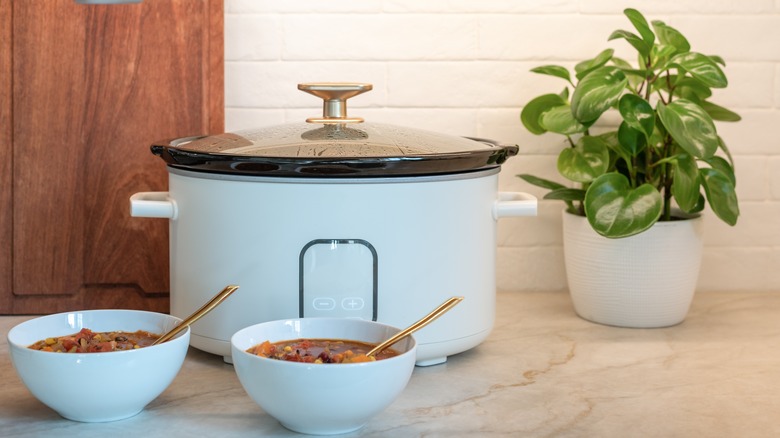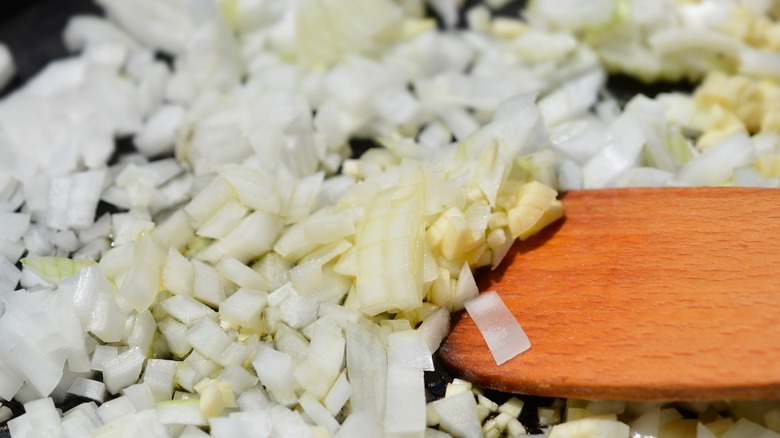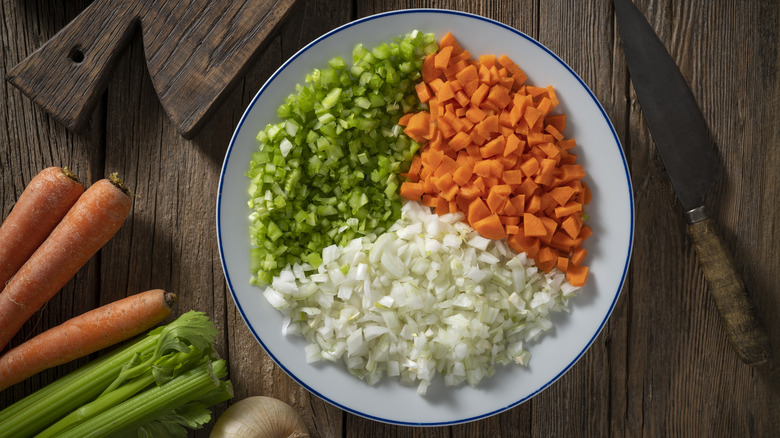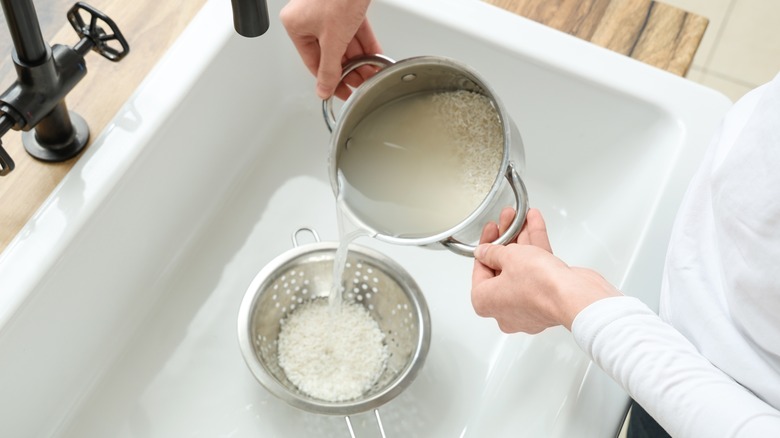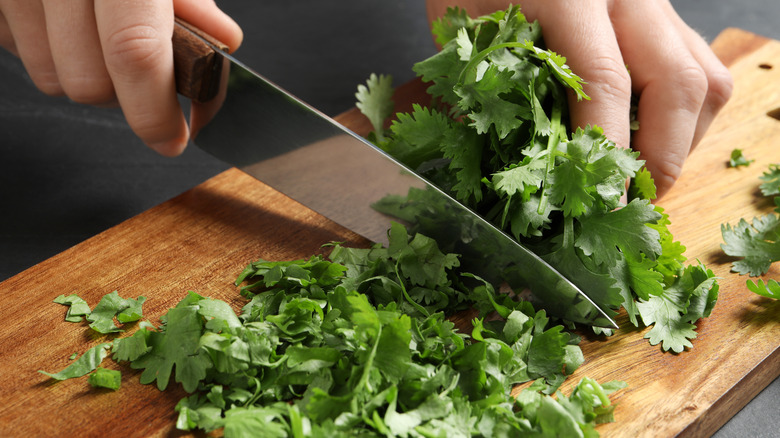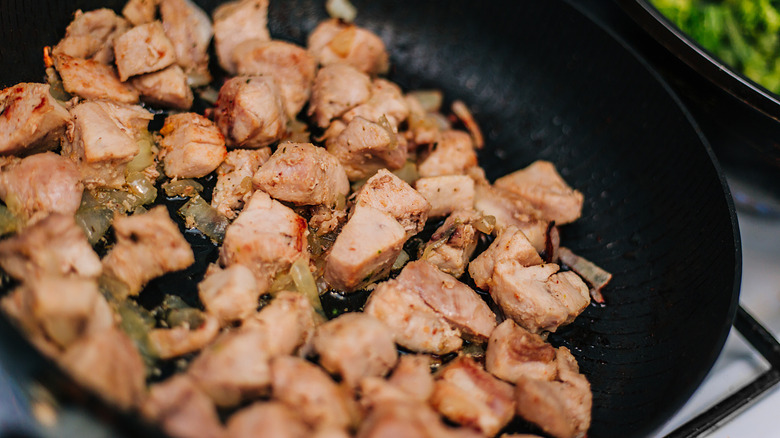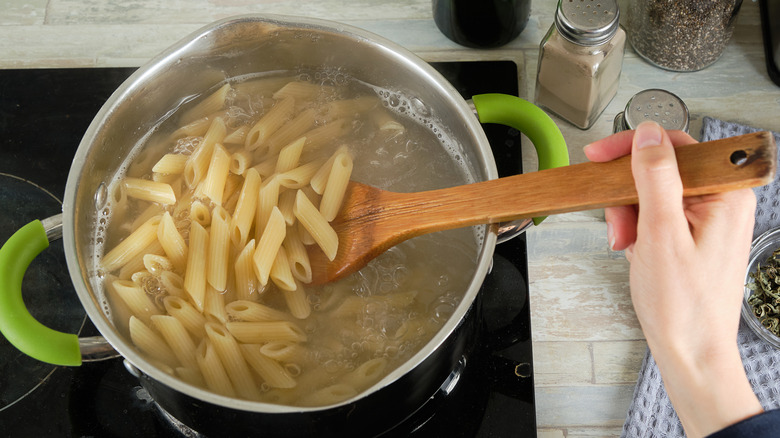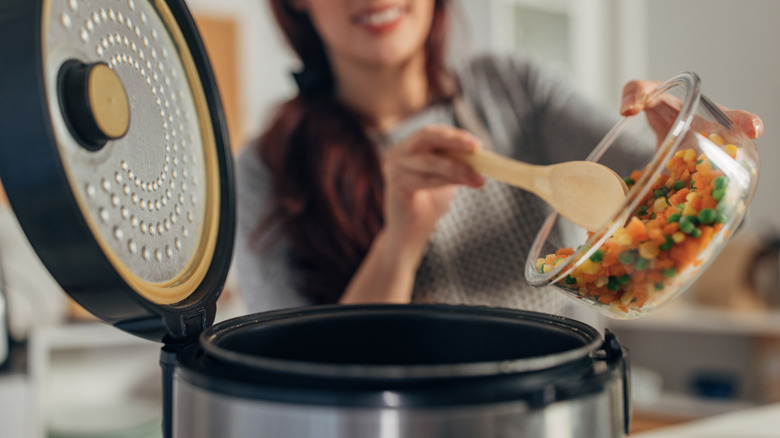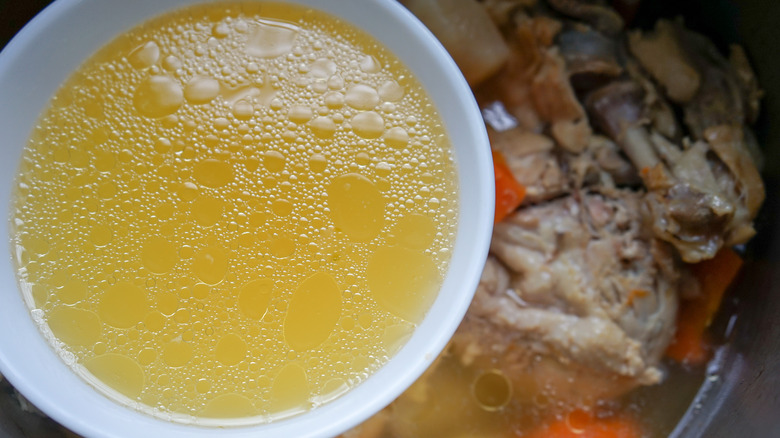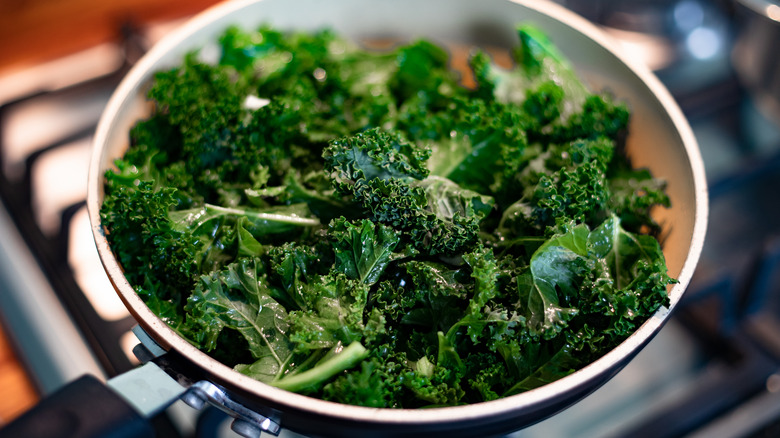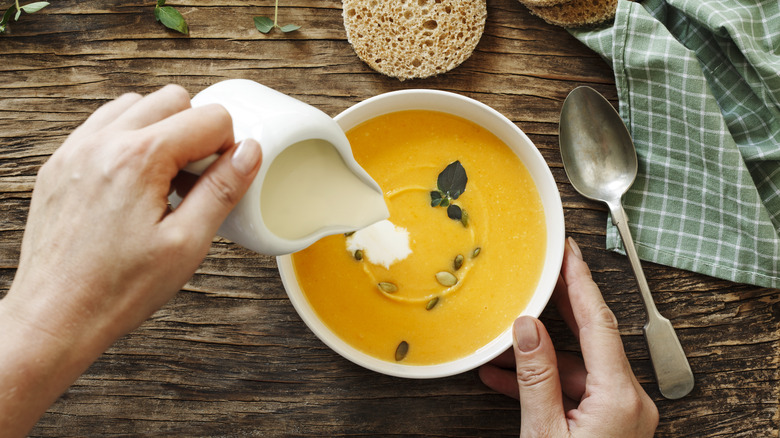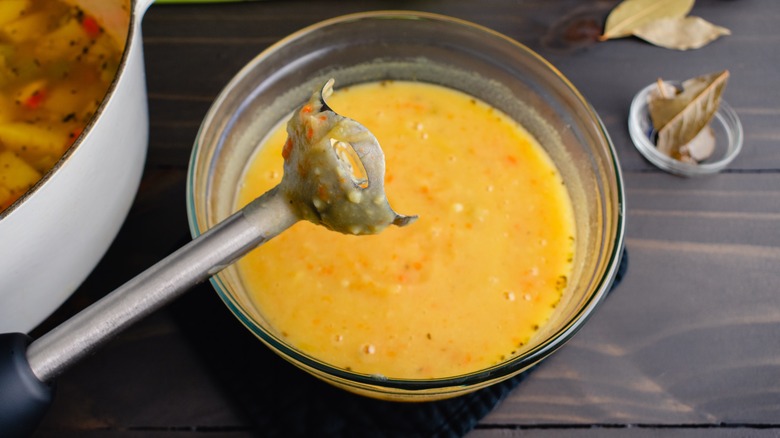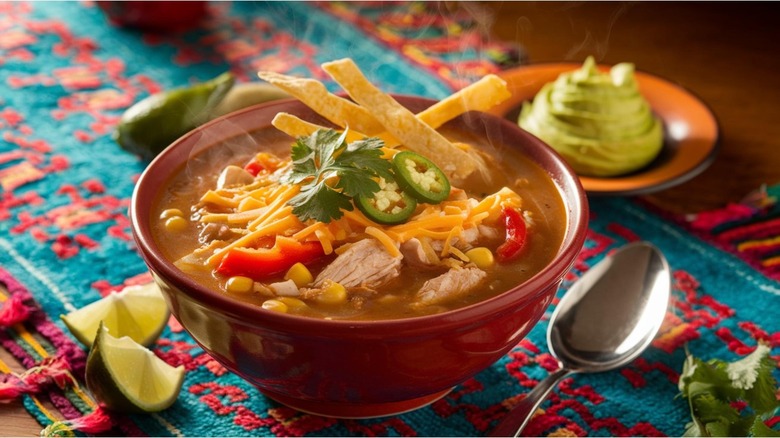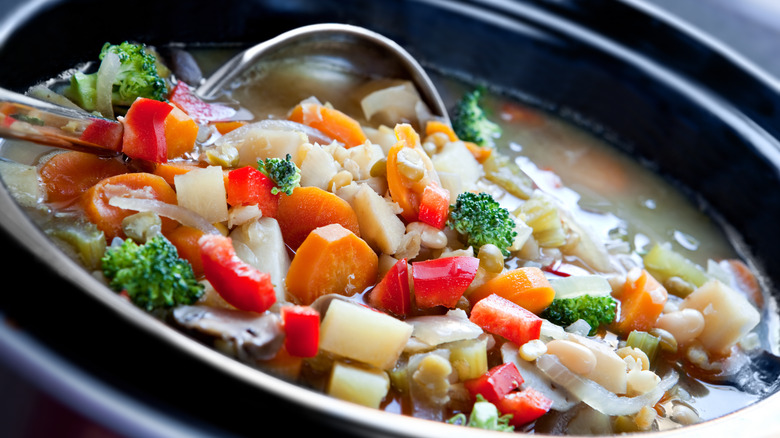A Crock Pot Veteran Shows Us 13 Mistakes To Avoid When Making Crock Pot Soup
You may think nothing is easier than making crock pot soup, and you wouldn't be entirely wrong if you did. Essentially, you just have to get all of the ingredients into the appliance, seal the lid, and let them slowly cook for hours. You can make almost any kind of soup you can think of in a crock pot, too. Even so, there are actually a handful of mistakes to avoid when making slow cooker soup if you want to achieve the best taste and texture, which, of course, you do.
I love a good crock pot soup, especially in the colder months of the year. The utter simplicity of making soup in a slow cooker really speaks to me and the room for error is seriously diminished. Best of all, slow cooker soup is the perfect way to use up whatever you have in your fridge and pantry, so I make it all the time. During my countless attempts at making crock pot soups and stews, I've experienced many mishaps and even more successes. In addition, I've looked into what celebrity chefs have to say about the matter. Keep reading to learn what all my trial and error adventures, research, and experience with crock pot soups have taught me, so you can skip the mistakes and make the most of every crock pot soup you prepare.
Not sautéing onions and garlic before putting them in the crock pot
For me, there's almost nothing better than the smell of onions and garlic frying in a pan. While the aroma alone is enough to make me want to add this combination of ingredients to almost every soup I make, the flavor of them after sautéing is the real draw. Sautéed onions and garlic have a much deeper, richer flavor than their raw counterparts, and this taste is something many soups are craving. While I have made crock pot soup many times with raw onions and garlic, it just isn't the same as when I take a few extra minutes to sauté them first.
Obviously, raw garlic and onion would cook up nicely in your crock pot along with everything else you are putting into a soup, but sautéing them transforms the flavor in all the right ways. The addition of oil in the frying pan doesn't hurt either because it soaks up the flavor and helps spread it throughout your soup in a delicious way. You don't need to sauté your onions and garlic for long, either. About five minutes on medium-low heat should suffice. Once your onions start to become translucent you should be all set. However, if you want a more caramelized, sweeter taste, you can sauté them for even longer.
Chopping ingredients too large or too small
Chopping ingredients in uniform sizes is recommended for just about any recipe. It ensures even cooking throughout a dish, and this includes soups made in a crock pot. In addition to uniformly sized pieces, dicing ingredients in chunks that are either too large or too small should be avoided. When you dice ingredients into super large pieces your soup will take much longer to properly cook. This could be fine if you have lots of time, but you still want your ingredients to be small enough that you can get several into a single spoonable bite. That way, you get a full mouthful of all the yummy elements you put into your soup.
Dicing your soup ingredients into small pieces reduces the amount of time they need in your crock pot. So, while this can be a good time-saver, you don't want to go too far. If you do, your ingredients will likely become too mushy if you have to leave it cooking unattended all day. Soup ingredients are seldom crunchy, so this may not sound all that awful, but it surely isn't ideal. You want your ingredients to be soft, but not so soft that they break up and lose their shape. The only exception to this is if you plan on blending it, like with a smooth potato or tomato soup.
Forgetting to rinse beans, lentils, and rice before adding them to the pot
There are two schools of thought when it comes to rinsing rice, some say it is essential and others think it is unnecessary. However, I think people who fall into the latter category have it wrong, particularly when making crock pot soup. The same goes for beans and lentils, too.
If you don't rinse your rice first, lots of extra starch gets into your soup, masking flavor along the way. In addition, un-rinsed rice adds a milky color to your soup's broth, making it look cloudier and less appetizing. So, don't make this mistake. Plus, rinsing rice only takes a few moments so there's no excuse not to.
I pretty exclusively use canned beans and lentils when I cook, so rinsing is a must. I certainly don't want to eat whatever slimy liquid they come in. I know some people don't care, but I prefer rinsing canned beans in a colander before adding them to anything I make, crock pot soup included. They may be a somewhat underrated canned food, but their convenience is undeniable, even with the rinsing. If your canned beans come in a chili sauce, you don't want to rinse them and waste all the yummy flavor. However, for every other kind of beans and lentils, rinsing is recommended.
Adding fresh herbs and citrus too soon
Fresh herbs and citrus are two of the best ways to amplify flavor in crock pot soup. Actually, it doesn't really matter what you're making, they turn up flavor in any recipe. However, when it comes to the slow cooker, adding them too soon is a mistake. Will it ruin your soup if you incorporate citrus and fresh herbs at the very start with all of the other ingredients? No. However, this is a surefire way to downplay their potency and lose lots of the bright, fresh flavor they are capable of providing.
With my crock pot soups, I like to add dried herbs and spices right from the start, and sometimes a touch of citrus too. Even so, I always wait until close to the end to add fresh herbs and spices and go all in with citrus. In fact, I often leave a good chunk of them on the side to use as garnishes for each individual bowl. This ensures they don't get lost in the mix while also promoting lots of fresh flavor in every bite.
Not searing meat before adding it to your crock pot soup
This next slow cooker tip I originally picked up from my great-grandmother, who was known for making the most delicious chicken and dumplings, so overlooking it would be a big mistake. She always seared the chicken before adding it to her slow cooker because as she would say, it just tastes better that way. Considering many recipes containing hearty cuts of meat call for searing it, I don't see any reason to question her reasoning either. If you had a chance to taste her cooking, you wouldn't, either.
In addition to my great-grandmother, Martha's Stewart blog also recommends searing meat before putting it in a slow cooker, and I'm more than inclined to heed her advice. In fact, she notes that it is a mistake to put meat in the slow cooker without searing it first. Why? Well, first of all, searing meat promotes more even cooking and that's always a good idea, regardless of the recipe. Second, searing meat gives it a nice caramelized taste and color, two things that assuredly make it more appealing.
Not cooking noodles separately
One of the biggest mistakes to avoid when making crock pot soup with noodles is to cook the pasta in the pot with everything else. Instead, I always cook noodles separately. Sometimes I leave them on the side and add some to a bowl before spooning my soup over the top. Other times I just wait until the end to mix them in. Either way, it ensures the noodles don't overcook, become mushy, and start breaking up. Even if you aren't as big of a fan of al dente noodles as I am, cooking soup noodles on the side allows for complete control over their texture.
I actually picked up this trick at one of the first restaurants I worked in. The soup of the day was frequently minestrone and the chefs always cooked the noodles on the side so we could build the bowl right before serving. They may have had several reasons for this, but the most noticeable difference was that the noodles retained a nice bite instead of just becoming super mushy. This was particularly beneficial for the restaurant because the soup was heated up for days at a time until it was all sold, but it can be just as helpful when making crock pot soup at home.
Putting too much in your crock pot
Overfilling your crock pot with soup ingredients is a big mistake. Actually, it's a mistake no matter what you are making. When your crock pot is packed full, it prevents even cooking throughout, and nobody wants that. It also means you'll have to extend the cooking time. With a crock pot this is not always a deal-breaker, I mean, it is a "slow" cooker, so you probably already expect your soup to take several hours to cook. Even so, there's no need to make it take even longer.
With soup in particular, putting too much in your crock pot is a surefire way to create a sticky, sloppy mess. You want to ensure you have enough room to comfortably stir the contents and broth without it splashing or spilling over the edges. With this in mind, it is best to only fill your crock pot about ¾ of the way full when making soup. If not, you may as well get a towel ready for cleanup before you even start.
Forgetting to reduce the amount of liquid you use
In general, converting a classic soup recipe for crock pot preparation is fairly easy. You still use all the same ingredients, it just takes longer to cook, like a lot longer. Aside from that, the only thing you really need to do is reduce the amount of liquid you use. While this is super simple, forgetting is a mistake. Unlike on the stove, the amount of broth you put in a soup won't reduce as much under the tightly sealed lid of a crock pot.
Instead of accounting for evaporation (like you do with a stovetop soup or stew), in a crock pot, you want to start with the right ratio of liquid to ingredients. The broth may reduce slightly, but don't count on it. When using a recipe, I tend to ignore the amount of broth listed and simply eye it. I add veggies and other ingredients and top it off with what I feel is the right amount of broth. It's pretty easy, don't overthink it. Just know that the ratio of liquid to ingredients you start with will likely be the same when it is time to eat. If you are making noodles on the side (which you know I recommend), you should also keep that in mind and add slightly more broth than looks ideal for the ingredients already in the crock pot.
Cooking leafy greens in the crock pot with the other ingredients
Leafy greens like spinach and kale are wonderful additions to many crock pot soups. However, I find it is best to keep them out of the mix until the end. This way, they retain some of their fresh texture and don't break down so much that they become slimy (something I hate). Instead of adding them with the other ingredients, I sauté them with a bit of oil or butter for a couple of minutes and then stir them into the soup right at the end. Sometimes, I don't even cook kale or spinach and opt to use them as a garnish on each bowl. Either way, it's best to keep leafy greens out of your crock pot until your soup is almost ready.
The only exception to this rule that I can think of is collard greens. As a more bitter tasting leafy green, it benefits greatly from being cooked in the broth and other ingredients for a considerable amount of time. So, if you're making something like a slow-cooker Southern black-eyed pea soup, I recommend putting the greens straight into the pot, no sautéing necessary. They don't need to cook in the pot the entire time, but adding them for about an hour at the end will result in the ideal flavor and texture.
Not swapping heavy cream for evaporated milk in slow cooker soup recipes
Evaporated milk is one of many inexpensive canned foods you can use all the time if you keep it around, and guess what? One of the best ways to use evaporated milk is in crock pot soup. You can easily add a touch of evaporated milk to any soup you want to make creamy, like cauliflower soup, tortilla soup, chowder, and many more.
If you come across a soup recipe that calls for heavy cream, you can also swap it out for evaporated milk to get a silkier texture. A 1-to-1 ratio is perfect and not opting to try this substitution would be a big mistake. I tried it recently for the first time and was truly amazed at what a difference it made. Due to evaporated milk's condensed form, it gives slow cooker soup a creamier, richer texture. It leads to a yummy flavor too. Plus, as we know, you can't count on the liquid in your slow cooker to reduce (like it would on the stove), so starting with a condensed form of milk is a solid choice. You get all the extra creamy benefits without watering down the final product. Really, it's a win-win.
Not utilizing an immersion blender to smooth out some soups
Some people think you can blend any soup to turn it into a smooth, creamy dish — I'm not one of those people. I like chunky soups with lots of bite and varying texture. Even so, I am willing to admit that there are a handful of soups that simply taste better when blended. For example, tomato soup just isn't the same if it isn't smoothed out in the blender. Pumpkin, potato, and creamy carrot soup are other fantastic examples that fare well in the blender. When I opt to blend soup, I wait until it is hot and the flavors have had a chance to permeate all of the ingredients. Then, I blend it right before serving. I typically do a final taste test and sometimes add some more seasoning, but I generally wait to blend until right before I serve it so that the texture stays spot on.
An immersion blender makes smoothing out soups super easy. All you have to do is stick it straight into your crock pot and give your soup a whirl. If you don't have an immersion blender, you can also use a standard, upright blender. However, this typically turns into more of a mess because you'll have to transfer your hot soup to the blender canister. Still, it's a perfectly viable option. When you're in the mood for an ultra-smooth soup, don't forget about your blender, immersion or otherwise.
Forgetting to serve your soup with tasty garnishes and crusty bread
Just like soup you make on the stove or in a Dutch oven, crock pot soup deserves a finishing touch once you spoon it into a bowl. Does it absolutely need one? No, but added garnishes certainly won't hurt. In fact, they'll do the exact opposite. Depending on what you garnish your soup with, it has the potential to add lots of yummy texture and flavor.
Some of my favorite garnishes for soup include cheese, a squeeze of lemon or lime, diced green onions, avocado, and fresh herbs. Not only do they do wonders for flavor and texture, but they pair well with almost any soup. I also like sticking corn chips into chilis and tortilla soup. Crispy chopped bacon is another game-changer for many soups. I like to make vegetarian soup and then serve bacon on the side so meat eaters will fall in love too. Even if you don't put anything straight into your bowl, a slice of crusty bread or some crackers on the side will never let you down. They help soak up tasty broth, allowing you to savor every last drop.
Thinking taking out the crock pot and eventually cleaning it is too much work
After all we have learned so far, using your crock pot may sound a bit more labor-intensive than you anticipated. Don't let all the details weigh you down though. One of the biggest mistakes you should avoid is thinking that taking out your crock pot and eventually cleaning it isn't worth the effort. It is! It's not like it's a tricky appliance to clean. Sure, many of them are pretty large, but for the most part, you should be able to remove the pot and clean it just like any other dish.
You may need to wash more dishes than just your crock pot, like a cutting board, knife, and maybe even a frying pan, but that's okay too. Even if using your crock pot doesn't result in fewer dishes, it saves you tons of time along the way. You don't have to watch over a pot, shoot, you don't even have to be home for your crock pot to cook you a delicious meal. So, if using your slow cooker sounds like a lot of work, it isn't. It will actually save you tons of time, and a little effort too.

